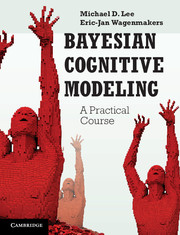
-
Select format
-
- Publisher:
- Cambridge University Press
- Publication date:
- 05 June 2014
- 03 April 2014
- ISBN:
- 9781139087759
- 9781107018457
- 9781107603578
- Dimensions:
- (246 x 189 mm)
- Weight & Pages:
- 0.7kg, 280 Pages
- Dimensions:
- (246 x 189 mm)
- Weight & Pages:
- 0.55kg, 280 Pages
You may already have access via personal or institutional login
Book description
Bayesian inference has become a standard method of analysis in many fields of science. Students and researchers in experimental psychology and cognitive science, however, have failed to take full advantage of the new and exciting possibilities that the Bayesian approach affords. Ideal for teaching and self study, this book demonstrates how to do Bayesian modeling. Short, to-the-point chapters offer examples, exercises, and computer code (using WinBUGS or JAGS, and supported by Matlab and R), with additional support available online. No advance knowledge of statistics is required and, from the very start, readers are encouraged to apply and adjust Bayesian analyses by themselves. The book contains a series of chapters on parameter estimation and model selection, followed by detailed case studies from cognitive science. After working through this book, readers should be able to build their own Bayesian models, apply the models to their own data, and draw their own conclusions.
Reviews
‘This book provides the best practical guide to date on how to do Bayesian modeling in cognitive science.’
Jay Myung - Ohio State University
‘This is a very powerful exposition of how Bayesian methods, and WinBUGS in particular, can be used to deal with cognitive models that are apparently intractable. When we produced WinBUGS, we had no idea it could be used like this - it's amazing and gratifying to see these applications.’
David Spiegelhalter - Winton Professor for the Public Understanding of Risk, Statistical Laboratory, Centre for Mathematical Sciences, Cambridge
Contents
Metrics
Altmetric attention score
Full text views
Full text views help Loading metrics...
Loading metrics...
* Views captured on Cambridge Core between #date#. This data will be updated every 24 hours.
Usage data cannot currently be displayed.
Accessibility standard: Unknown
Why this information is here
This section outlines the accessibility features of this content - including support for screen readers, full keyboard navigation and high-contrast display options. This may not be relevant for you.
Accessibility Information
Accessibility compliance for the PDF of this book is currently unknown and may be updated in the future.


